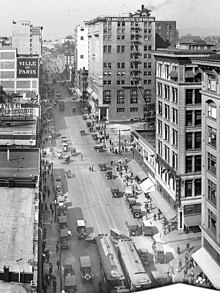B. H. Dyas
| Industry | Retailing |
|---|---|
| Predecessor | Dyas & Cline |
| Founded | 1905 in Los Angeles |
| Founder |
|
| Defunct | 1932 |
| Fate | Bankruptcy |
| Headquarters |



B. H. Dyas Co. was a Los Angeles sporting goods retailer that turned into a department store and went out of business in the 1930s, owned by Bernal Hubert Dyas (1882–1959).[1]
Origins as sporting goods store
[edit]Dyas opened a sporting goods store, Dyas & Cline, with partner George T. Cline at Main & 3rd (116 E. 3rd St.) in 1905.[2] Later, Dyas was located on 7th at Hill.
Seventh & Olive department store
[edit]In 1919, the owners of the Ville de Paris department store at 321-5 W. 7th Street at Olive, sold the store to Dyas.[3] The store advertised as "Ville de Paris–B. H. Dyer Co." from 1919 through 1927, then simply as B. H. Dyas. The Downtown store and with it, the B. H. Dyas name, closed around 1930. The Seventh and Olive building is now occupied by the Los Angeles Jewelry Mart, a constituent of what is now the Jewelry District, part of the Historic Core district.[4]
The store advertised as “The Most Interesting Store in California”. It had inside a log cabin, a rifle range, and an aquarium of rainbow trout, as well as stuffed and mounted game animals.[5]
Hollywood branch
[edit]In 1927, Dyas opened a branch in Hollywood in what is now the Broadway Hollywood Building. In 1922,[6] stock was sold to finance its construction to house a branch of Boadway Bros., which went out of business in 1923, and B. H. Dyas agreed to open in the building instead.[7] The Classical Revival Style building was built by local businessman Frank R. Strong to house Dyas' store. Frederick Rice Dorn was the architect. The construction, which continued into 1928, marked the first department store branch outside of the main Downtown Los Angeles central business district and led to similar large-scale commercial developments outside downtown such as Bullocks Wilshire.[8] Due to the Great Depression, B. H. Dyas had to consolidate its operation back to its original store and The Broadway purchased the 30-year lease for $2 million (US$40.1 million in 2023 dollars[9]) in 1931.
Demise
[edit]The 7th and Olive store went into receivership in 1932, and closed in 1933,[10] thus ending the B. H. Dyer department store. Myer Siegel came to occupy the 7th & Olive building.[11]
Dyas' son died in an automobile collision in Rawlins, Wyoming in October 1933.[12] Dyas died in 1959.[1]
References
[edit]- ^ a b "Civic Leaders Attend Rites for B. H. Dyas". Los Angeles Times. January 13, 1959. Retrieved 17 May 2019.
- ^ "New Sporting Goods House to be Formally Opened". Los Angeles Times. September 11, 1905. Retrieved 17 May 2019.
- ^ "The Ville de Paris in the Homer Laughlin Building at 317 South Broadway, ca. 1910 … After the Fusenots sold the store in 1915, new owners, with an interest in San Francisco's Emporium, moved it to Olive and Seventh streets across from Coulter's. The business was taken over by the B. H. Dyas Company in 1919." in Berkeley Square: Resurrecting a West Adams Street Lost to the Freeway, Duncan Maginnis, 2015
- ^ "Ville de Paris, 19 years ago and today". Los Angeles Herald. November 9, 1912. Retrieved 17 May 2019.
- ^ Strolling along Seventh Street (PDF). Los Angeles Conservancy. 2010.
- ^ "Advertisement for Boadway Bros., Inc". Holly Leaves (magazine). July 1, 1922. p. 37. Retrieved July 13, 2020.
- ^ Williams, Gregory Paul. The Story of Hollywood. p. 233.
- ^ Williams, Joshua (2005-08-08). "Broadway Hollywood Building Historical Information". City of Los Angeles – Mayor's Office of Economic Development. Retrieved 2014-08-08.
- ^ 1634–1699: McCusker, J. J. (1997). How Much Is That in Real Money? A Historical Price Index for Use as a Deflator of Money Values in the Economy of the United States: Addenda et Corrigenda (PDF). American Antiquarian Society. 1700–1799: McCusker, J. J. (1992). How Much Is That in Real Money? A Historical Price Index for Use as a Deflator of Money Values in the Economy of the United States (PDF). American Antiquarian Society. 1800–present: Federal Reserve Bank of Minneapolis. "Consumer Price Index (estimate) 1800–". Retrieved February 29, 2024.
- ^ "Advertisement for auction of B. H. Dyas 7th Street store fixtures". Los Angeles Times. August 20, 1933. p. 10. Retrieved 17 May 2019.
- ^ "Store's Modern Home to Open Tuesday". Los Angeles Times. September 2, 1934. p. Part I p. 19. Retrieved 17 May 2019.
- ^ "BH Dyas son dies in car crash". The Independent-Record. Helena, Montana. 8 October 1933.
